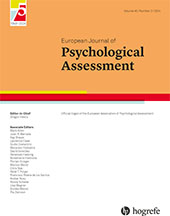Abstract
Abstract: This study examined the cross-group and temporal measurement invariance of the Satisfaction With Life Scale in Korea. A nationally representative sample (N = 13,824) and a convenience sample collected at four-time points over approximately 14 months (N = 338) were used. Full measurement invariance (i.e., equal factor loadings and intercepts) was supported across groups based on gender, age, education, data collection method (face-to-face versus non-face-to-face), and two alternative translations of the scale. Temporal measurement invariance was also supported. Accordingly, the same underlying construct is measured, and the items of the scale are understood and answered similarly across groups and across time in Korea. Supplemental analysis revealed that Item 5 was not invariant between Korea and Japan, with Korean respondents tending to rate this item higher than Japanese respondents.
References
(2019). Factors associated with inattentive responding in online survey research. Personality and Individual Differences, 149, 157–159. https://doi.org/10.1016/j.paid.2019.05.043
(2018). Measurement agreement of the self-administered questionnaire of the Belgian Health Interview Survey: Paper-and-pencil versus web-based mode. PLoS One, 13(5), Article
e0197434 . https://doi.org/10.1371/journal.pone.0197434(2007). Sensitivity of goodness of fit indexes to lack of measurement invariance. Structural Equation Modeling: A Multidisciplinary Journal, 14(3), 464–504. https://doi.org/10.1080/10705510701301834
(1985). The Satisfaction With Life Scale. Journal of Personality Assessment, 49(1), 71–75. https://doi.org/10.1207/s15327752jpa4901_13
(2017). Measurement invariance of the Satisfaction with Life Scale: Reviewing three decades of research. Quality of Life Research, 26(9), 2251–2264. https://doi.org/10.1007/s11136-017-1552-2
(2016). The effect of face-to-face interviewing on personality measurement. Journal of Research in Personality, 63, 133–136. https://doi.org/10.1016/j.jrp.2016.05.006
(2019). Measurement invariance of the Serbian version of the Satisfaction With Life Scale across age, gender, and time. European Journal of Psychological Assessment, 35(4), 555–563. https://doi.org/10.1027/1015-5759/a000410
(2015). Principles and practice of structural equation modeling. Guilford Press.
(2019). Measurement invariance of the Satisfaction With Life Scale (SWLS) across age and gender. Journal of the Korean Psychological Association: Cultural and Social Issues, 25(4), 305–323.
(2015). Longitudinal structural equation modeling: A comprehensive introduction. Routledge.
(2009). Longitudinal invariance analysis of the Satisfaction With Life Scale. Personality and Individual Differences, 46(4), 396–401. https://doi.org/10.1016/j.paid.2008.11.002



